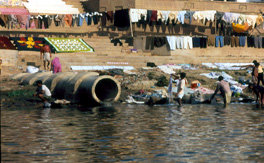Greening the Blue Report 2016
The United Nations emitted 2 million tonnes of carbon dioxide (CO2) equivalent in 2015, according to the organization's annual report of its greenhouse gas emissions. The latest edition of the Greening
The United Nations emitted 2 million tonnes of carbon dioxide (CO2) equivalent in 2015, according to the organization's annual report of its greenhouse gas emissions. The latest edition of the Greening
<p>The world's urban population now exceeds the world's rural population. What does this mean for the state of our cities, given the strain this global demographic shift is placing upon current urban infrastructure?
At the fourth meeting of the POPRC in October 2008 the European Community and its Member States being parties to the Stockholm Convention have proposed endosulfan to be listed in Annex A, B or C of the Convention (UNEP/POPS/POPRC.4/14). At its 5th meeting in October 2009 the POPRC reviewed and adopted a revised draft risk profile on endosulfan.

Gorillas, the largest of the great apes, are under renewed threat across the Congo Basin from Nigeria to the Albertine Rift: poaching for bushmeat, loss of habitat due to agricultural expansion, degradation of habitat from logging, mining and charcoal production are amongst these threats, in addition to natural epidemics such as ebola and the new risk of diseases passed from humans to gorillas.

This new UN report presents challenges of unregulated wastewater discharged into rivers and seas. Calls for transforming wastewater into clean and economically attractive resource & details strategies that focus on sustainable water management.

This report from the United Nations Environment Programme addresses the urgency of controlling pollution and preserving water quality around the world. Uses case studies to illustrate both problems and solutions and details key recommendations to improve and protect water quality for the international community, national governments, communities and households.
The objectives of the case studies are to determine the potential of indigenous knowledge in strategically contributing to mitigation and adaptation to climate change. The case studies assess the indigenous knowledge practiced and applied by local communities in East, West and Southern Africa regions and
The thematic VIA Module is part of the Integrated Environment Assessments training manual, volume two. It presents a methodology to assess vulnerability to, and impacts of climate change at national and sub-regional level.
This discussion paper on Industry Sector Approaches to Climate Change is intended to assist negotiators, policymakers and other interested parties in the definition, development and implementation of sectoral approaches. In doing so, it seeks to provide a broad introduction to non-specialists on the subject of sectoral approaches.
This paper assesses the capacity of organic and resource-conserving agriculture (ORCA) to improve the livelihoods of poor smallholders in Africa. Distinguishing among the different practices related to ORCA is sometimes difficult because
Despite the protection afforded by several important legal instruments, the environment continues to be the silent victim of armed conflicts worldwide. The United Nations Environment Programme (UNEP) has conducted over twenty post-conflict assessments since 1999, using state-of-the-art science to determine the environmental impacts of war.